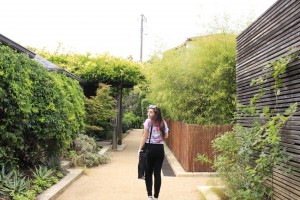VISU1311: Creative Blog #3
Shelby Charette
Robinson
VISU1311
August 30, 2015
What is Design?
Kenya Hara, in his work “What is Design”, thoroughly covers design history and progress over the years, from the beginning until now. He explains design from the beginning, how, from the use of our hands and tools we have evolved enormously into a primarily technology based driven environment and everything in between. “What is Design?” was a truly fascinating read, it covered even the most basic characteristics of design and explaining the importance of even the most minuscule everyday items and how they have been influenced by design and goes on to explain how the foundation was built for design today.
It is very interesting to see how design has flourished and seeing the influences that change it. As Hara states, our first tools were our hands, now looking at our society, technology is the one of the main influences on design. Although seeming like a technology based field, Hara declares that design will never depend solely on technology. He emphasizes that “design is not subordinate to media; design explores the essence of media (Hara, 436).” Design depends not only on technology but also on the economy, time, with our environments, and our resources, such as how war effected design throughout the century.
Even as technologically advanced as our generation is, Hara emphasizes how no matter how advanced we think we are, things will keep evolving and changing. Each generation gains more intelligence and has a more open environment to explore design, therefore gaining more knowledge about design and how to use their resources to create something ground-breaking. We learn to harness new resources, we learn to conquer new technologies, we constantly adapt and strive for better.
Lastly, Kenya Hara’s evaluation, summary, and explanation of design’s lengthy past from the beginning, describes the foundation on which design was created and has become what it is today. Our society will continue to forever keep improving and using our resources to our advantage to create more and more superior designs.
VISU1311 Blog Post #2
Shelby Charette
August 30, 2015
Robinson
VISU1311
Creativity Blog #2: High Concept High Touch
Throughout Daniel H. Pink’s writing, he expresses the significance and difference of both L-Directed thinking and R-Directed thinking. L-Directed thinking, refers to a more logic-based, and emotionless side of thought, while R-Directed thinking is a more empathetic, creative, and emotional way of thought. Throughout Daniel H. Pink’s analysis of the evolution of society from uniform thought, like from the Agricultural age, to today’s Conceptual age, a more broad and artistic approach to thinking; Pink shows the intensifying use of R-Directed Thinking that is being used today, along with the changes it is creating in society.
The importance of the R-Directed thinking is not only being used primarily by artists, but is being currently implemented in places such as medical schools, to broaden the way of thinking and stray from a uniform point of view and be used to find alternate solutions to issues. The population of the “creatives” is booming (Pink, 56). The subcultural creative thinkers are allowing businesses to expand, jobs to be created, and industries to bloom. Most products on the market today are mainly made to appeal to the aesthetic and useful side that consumers want. Therefore, the L-Directed thinkers and R-Directed thinkers in this case, work together to create a product that is useful, productive, and revolutionary (L-Directed), while the R-Directed thinkers make the product visually striking to appeal more to their target audience.
The use of R-Directed thinking being implemented into standardized testing could very well benefit the creative thinkers of the future. Pink states that only about 4-10% of IQ actually is related to your career (Pink, 58), yet standardized tests mainly focus on logic based questions, to evaluate the effectiveness of the L-Directed thinker. Our generations are evolving their processes to thinking, becoming more abstract than logic based, therefore the sooner we help implement creative thinking into learning than the more successful the next generations will become.
Ultimately, the influence this thought process has on our society today is monumental. It is changing almost everything we know; from jobs, to industries, and just the overall concept of thought. This R-Directed thought process is opening up opportunities for all creative thinkers.
VISU1100: Blog Post #1
- What are the main points of each article? The main prominent points each article, is to somewhat compare the two careers. It shows how strikingly similar they can be, showing an uncanny amount of shared qualities between them. It also implies the growing popularity of art as a career and how incredibly closely related they are to one another. When reading the article, I believe that I feel as if it should persuade people to respect artists more than they usually do. It shows them as more of a vital, and important part of society by comparing them to the entrepreneurs since most people do not see artists in that way.
- What can artists learn from their “entrepreneurial cousins”? Artists, mainly are isolated by choice, although in order for them to succeed as an entrepreneur, they would need to learn to accept assistance and learn to work in teams.
- Do you agree that artists are entrepreneurs? why? I agree that artists are entrepreneurs, because in order to sell, advertise, or promote their art, they have to know how to intrigue their target audiences. This did not used to be the case back in the day, but with modern technology, their options to find ways to sell/promote are limitless.
- Which of the 12 characteristics of artists do you agree with? I agree with all twelve characteristics, because I understand the reasoning on why artists and entrepreneurs are alike. Although if I had to choose one particular characteristic that I believe fits best, would be that artists are passionate ability their work. For an artist, their world revolves around their art. They are always looking for new ideas and always thinking about their art, it is a large part of them.
- What others would you add to the list? Both entrepreneurs and artists need to be open to see from a different perspective. I believe perspective is important because for an entrepreneur, if something they’re working on is not working, they will have to trouble shoot or look from a different perspective, such as a client’s perspective to see what changes need to be made in order to improve their product. This also applies to artists, for them to fix a problem or improve, they would need to see their work from a different perspective. Most people are stuck in their ways, but being open to perspective can allow a chance to improve what needs to be improved upon.
- Additional notes. The article was very informative. It really looked at artists as more of a professional career, rather than a hobby.
Part 2-
- I have grit, but I would like to work on managing my stress levels. I stick to what I need to do and I am diligent, but I need to work on stress levels.
- Working with a strict schedule along with necessary relaxation could improve my ways of dealing with stress and keeping myself on track.
Visu1311: Blog Post 1
Shelby Charette Charette 1
August 25, 2015
Robinson
Visual Studies 113
In Vilem Flusser’s work, “The Photograph,” the views of photographs are deeply contrasted from the perspective of the artist and a conventional person. Flusser criticizes the naiveté shown from an ordinary person, how a picture is, just that; a picture. When seen though the eyes of an artist, it is art, it has meaning, it tells a story.
While Flusser is always searching for the deeper meaning, he realizes that not everything is merely just black and white. There is not just one right answer, its as if the possibilities are endless. Flusser, although seemingly critical of the simple point of view, appears to have a sense of curiosity, as if to say, “What would it be like if I saw things that way? To be able to look at a tree and not seek any deeper meaning, but to just admire it”.
Flusser explains the dependence the photographer has with his or her camera and the relationship they share. He explains the balance in the relationship, how they are both immensely dependent on one another. The photographer, uses his or her camera to capture the intended images, while the camera needs the photographer to use it to its full potential in an effort to expand and broadcast the significance of art.
Therefore, Flusser deeply analyzes the diverse characteristics and significance of perspective, and the relationship between an artist, their art, and the audience.
Hello world!
Welcome to your brand new blog at St. Edwards University Sites.
To get started, simply log in, edit or delete this post and check out all the other options available to you.
For assistance, visit our comprehensive support site, check out our Edublogs User Guide guide or stop by The Edublogs Forums to chat with other edubloggers.
You can also subscribe to our brilliant free publication, The Edublogger, which is jammed with helpful tips, ideas and more.





